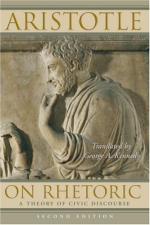|
This section contains 635 words (approx. 2 pages at 400 words per page) |

|
On Rhetoric: A Theory of Civic Discourse Summary & Study Guide Description
On Rhetoric: A Theory of Civic Discourse Summary & Study Guide includes comprehensive information and analysis to help you understand the book. This study guide contains the following sections:
This detailed literature summary also contains Topics for Discussion and a Free Quiz on On Rhetoric: A Theory of Civic Discourse by Aristotle.
Rhetoric is defined as "the faculty of observe in any given case the means of persuasion" (24) and, therefore, is used by all arts and sciences in order to persuade audiences of some specific point. Rhetoric is used in three specific fields: politics, the legal system, and ceremonially. Each of these fields makes different demands upon the rhetorician's arguments and style.
Rhetoric is neither an art nor a science, which means that it does not have its own particular subject of study. Rather, it is used by all other arts—like medicine, architecture, and so on—in order to convincingly present conclusions. Rhetoric, unlike dialectic or logic, is not primarily concerned with speaking the truth, but with providing a convincing argument. Those who use rhetoric for dishonest purposes, therefore, are still considered rhetoricians, while a person who attempts to misuse logic to make his arguments is not really a dialectician, but a sophist. Rhetoric is generally used for three different purposes: political, forensic or legal, and ceremonial or epideictic. Political rhetoric is used when trying to convince a legislature or ruler about some particular course of action. It is distinguished from the other forms of rhetoric particularly by its emphasis on the future. Forensic or legal rhetoric is used when arguing in court over some particular criminal charge and is used both on behalf of and against the person charged. Since a criminal trial is always concerned with some action that is believed to have already happened, forensic rhetoric is particularly concerned with the past. Ceremonial or epideictic rhetoric is the least argumentative of the three fields. It is used to either praise or denounce some figure. Though the subject of one's discussion may be some past figure, the epideictic speaker usually is concerned with someone who is still living.
As the rhetorician's chief concern is not the truth but being persuasive, he must be aware of all the ways in which people are convinced of an argument. This means that he must be well-versed in valid argumentation, but he should also be sensitive to the emotions of his audience, which, especially when dealing with uneducated people, can be more powerful than reason. He should know the nature of all of the emotions, their typical causes, and how people experiencing those emotions are likely to act and think. By manipulating his audience's emotions, the rhetorician will make his task of persuasion much easier. The character of the speaker himself is also an important part of any speech, as people are more willing to believe someone they believe to be good and sensible. As such, the rhetorician should know how to effectively portray himself as someone deserving of trust and, conversely, how he can prejudice the audience against his opposition.
A rhetorician must also be a master of style, for knowing what to say will not be enough if one does not say it well. A good style is, first of all, clear, for no speech can be effective if the audience does not know what is being said. Therefore, the speech should largely mirror ordinary speech, though it ought to distinguish itself in some ways to make it appear lofty and special. A successful rhetorician will adapt the style of his speech to the proper setting. A political speech should generally be simple and direct, for the audience is unlikely to be swayed by rhetorical flourishes. A ceremonial speech, on the other hand, which usually addresses a general audience, should avoid complex reasoning as much as possible and make everything simple and clear for the listeners. Structurally, a speech is divided into two parts: the statement of the argument and its proof. In some cases, it is acceptable to place an introduction and epilogue at the beginning and end, respectively.
Read more from the Study Guide
|
This section contains 635 words (approx. 2 pages at 400 words per page) |

|



